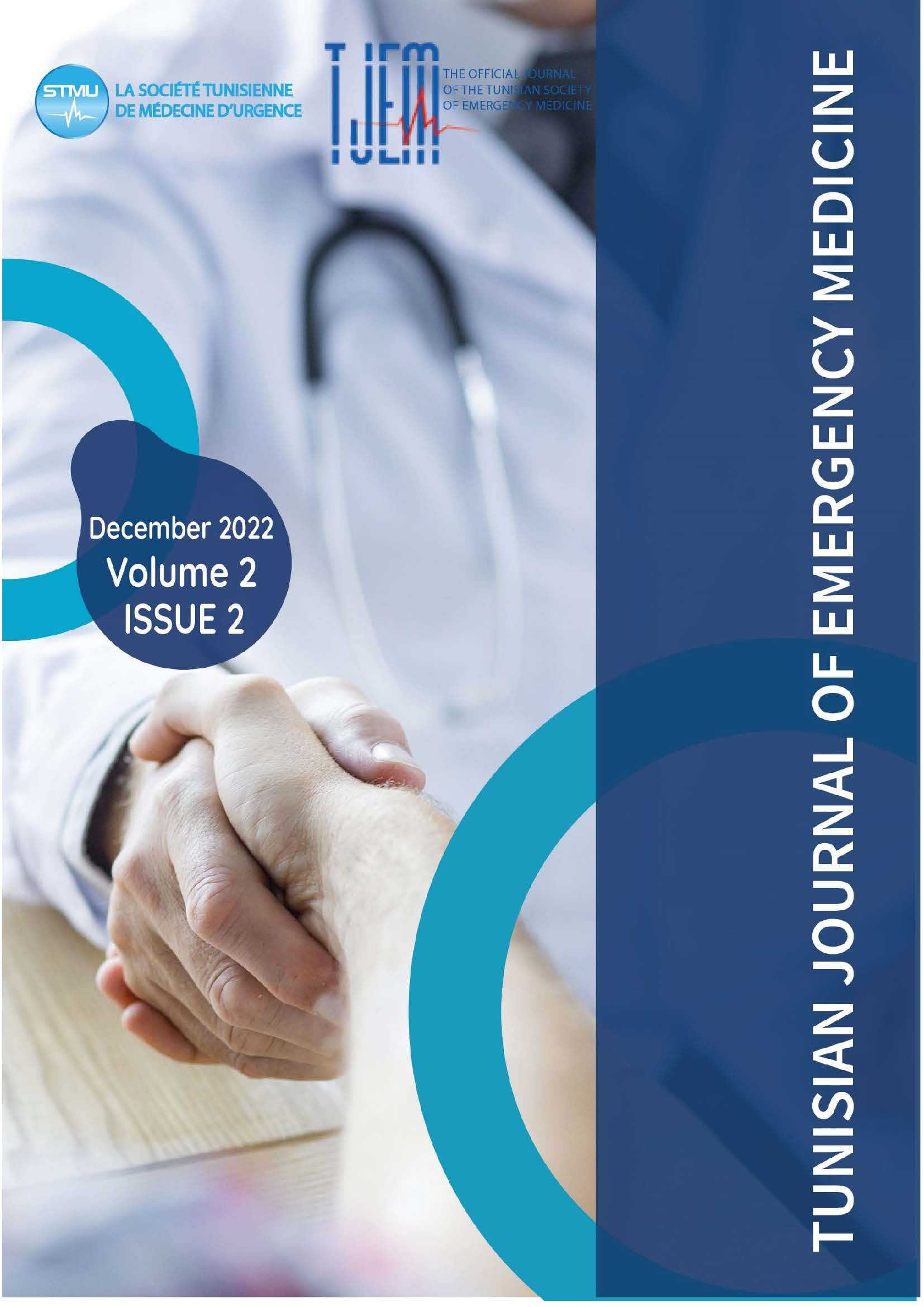Short and long-term outcomes of patients presenting with Acute Coronary Syndrome without ST-segment elevation (NSTE -ACS): findings from a Tunisian Register: the ReSCUS Register
Rahma JABALLAH, Hajer YAAKOUBI; Lotfi BOUKADIDA; Rym YOUSSEF; A BACCARI; Asma ZORGATI; Riadh BOUKEF
DOI:
https://doi.org/10.0000/p3kcxj09Keywords:
Acute coronary syndrome;, Emergency department, Management, DelayAbstract
Background: Chest pain is one of the most common complaints in the emergency department. Acute coronary syndrome with ST-segment elevation remains the ultimate medical emergency. However, acute coronary syndrome without ST-segment elevation (NSTE -ACS) has an equivalent prognosis risk. The major challenge of the emergency physician is the rapid and accurate identification of patients with ACS who would benefit from immediate care.
Objective:
Evaluation of our practices according to European Recommendations for the management of NSTEACS and assessment of short and long-term prognosis for major cardiovascular events (MACE).
Methods: This is an analytical study, involving 850 patients treated for NSTE-ACS for 2 years in the emergency department. Data were collected from the acute coronary syndromes’ local register (ReSCUS register). The main results were: the different delays in medical care, length of stay in the emergency department, short-term complications, and the occurrence of MACE registered at one month, six months, and one year later.
Results: The average age of our patients was 64 +/- 11 years. The sex ratio was 2.2. Hypertension and diabetes are the two most common risk factors in our population. NSTE-ACS was inaugural in almost a third of the cases. Only 7% of the patients have been referred to the ED by a medical team.
In 16.2% of cases, the initial ECG found no repolarization disorder. The average first medical contact delay was 24.4 +/- 30.2 min. The average first qualifying ECG delay was 30 +/- 0.6 min. The average length of stay in the emergency department before admission to the cardiology department was 24.1 +/- 21.3 hours. More than half of the sample (68%) had their angiograms within 48 hours. Among the 500 followed-up patients, 12 were completely lost. Patients who presented at least one MACE were
at one month: 58 patients (11.6%) at 6 months: 112 patients (22.4%), and at 1 year 136 patients (27.2%).
Conclusion: Cardiovascular disease is the leading cause of death worldwide. Assessment of our practices is important to improve prognosis. Registers offer a guarantee of methodology and are a real mirror of our medical care.
Downloads
Published
Issue
Section
License
Copyright (c) 2022 Tunisian Journal of Emergency Medicine

This work is licensed under a Creative Commons Attribution-NonCommercial-ShareAlike 4.0 International License.
How to Cite
Similar Articles
- Faiza Safi, Traditional Medicine with Cade Oil in Pediatric Emergency Care , Tunisian Journal of Emergency Medicine: Vol. 2 No. 4 (2024): TJEM Vol2 Issue4
- Sirine Bouzid, Rim Karray, Amine Abdelhedi, Fadhila Issaoui, Olfa Chakroun, Noureddine Rekik, MULTIVISCERAL DAMAGE FOLLOWING ACUTE METHOTREXATE INTOXICATION BY DOSING ERROR , Tunisian Journal of Emergency Medicine: Vol. 3 No. 1 (2025): TJEM 2025: Vol.3 Issue 1
- Randa dhaoui, Khaoula bel Haj Ali, Adel Sekma, Sarra Sassi , Wahid Bouida, semir nouira, The challenge in diagnosing human rabies: A case report , Tunisian Journal of Emergency Medicine: Vol. 3 No. 1 (2025): TJEM 2025: Vol.3 Issue 1
- olfa djebbi, A dramatic course of COVID-19-associatedmeningoencephalitis without respiratoryinvolvement: a case report , Tunisian Journal of Emergency Medicine: Vol. 2 No. 4 (2024): TJEM Vol2 Issue4
- Houda BEN SOLTANE, Evaluation of the prescription of additional examinations in emergency departments , Tunisian Journal of Emergency Medicine: Vol. 2 No. 2 (2022): TJEM Vol2 Issue2
- Souayah Ahmed, Acute aortic syndromes in emergency departments , Tunisian Journal of Emergency Medicine: Vol. 2 No. 2 (2022): TJEM Vol2 Issue2
- Hanen GHAZELI, De Winters ST-T syndrome: an early sign of STsegment elevation myocardial infarction (A case report) , Tunisian Journal of Emergency Medicine: Vol. 2 No. 2 (2022): TJEM Vol2 Issue2
- Marwa TOUMIA, Fatma Zaouali, Lamia Bouzgarrou, Guillain–Barré syndrome after an asymptomatic COVID‐19 Infection: a case report , Tunisian Journal of Emergency Medicine: Vol. 3 No. 1 (2025): TJEM 2025: Vol.3 Issue 1
- Faten DHOUIB, Aimen Dammak, Faiza Safi, Fatma MHIRI, zied CHAARI, Successful Conservative Management of Penetrating Cervical Tracheal Injury: A Case Report , Tunisian Journal of Emergency Medicine: Vol. 3 No. 1 (2025): TJEM 2025: Vol.3 Issue 1
- Neila MAAROUFI, Firas Kessentini, Sabra Ouaz, Meriem Jemili, Moufida Nouari, Jihen Lakhal, Bilateral ptosis caused by midbrain hemorrhage: a case report , Tunisian Journal of Emergency Medicine: Vol. 3 No. 1 (2025): TJEM 2025: Vol.3 Issue 1
You may also start an advanced similarity search for this article.

